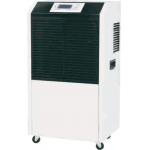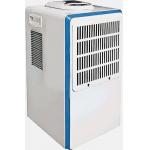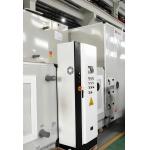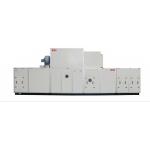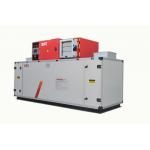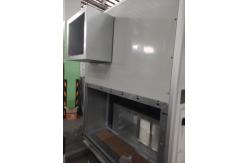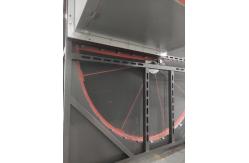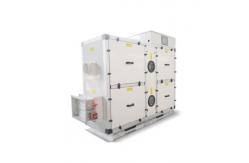Desiccant wheel dehumidifiers are highly efficient
moisture-removing devices widely used in industrial and commercial
settings. At the core of these machines is a rotating desiccant
wheel, typically coated with silica gel, molecular sieves, or other
hygroscopic materials. As air passes through the wheel, the
desiccant adsorbs moisture, effectively reducing humidity levels.
This continuous process allows for high-capacity dehumidification,
making it ideal for applications that demand strict humidity
control,
Compared to traditional refrigerant dehumidifiers, desiccant wheel
models can operate efficiently even in low-temperature environments
and achieve extremely low relative humidity levels (as low as 1%
RH), ensuring stable conditions crucial for sensitive processes and
product preservation. Their energy-efficient design, coupled with
minimal maintenance requirements, further enhances their appeal in
industries where humidity management is critical.
Structure of the Rotary Dehumidifier: Desiccant Wheel (Rotor): The core component is a large, porous
wheel made from a desiccant material (like silica gel or zeolite)
that absorbs moisture from the air. The wheel is divided into two
sections: the process air section and the reactivation air section. Air Inlet and Outlet: The device has separate air channels for
the process air (the air that needs to be dehumidified) and the
reactivation air (air used to regenerate the desiccant). Blowers/Fans: These move the air through the system, one for
the process air and one for the reactivation air. Heater: a heater is used to warm the reactivation air to regenerate
the desiccant material by releasing the absorbed moisture.
- Including small storage rooms, substations, museums, archives,
control rooms, pump houses, laboratories, etc.
- Key Requirements:
- Museums/Archives: Maintain humidity to prevent mildew damage to
cultural relics and documents.
- Substations/Control Rooms: Reduce corrosion risks to electrical
equipment from moisture, avoiding short circuits.
- Laboratories: Ensure constant humidity for experimental accuracy
(e.g., chemical analysis, biological culture).
- Covering production workshops, warehouses, and special technical
rooms.
- Typical Industries:
- Electronics Manufacturing: Prevent moisture damage to precision
components (e.g., semiconductor chips, PCB production).
- Pharmaceutical Warehousing: Comply with GMP standards to avoid drug
deliquescence.
- Lithium Battery Production: Control humidity to prevent electrolyte
deterioration and ensure battery safety.
- E.g., food processing plants, car washing workshops, or areas with
frequent water operations.
- Challenge: Moisture from processes (e.g., steam, cleaning) requires
continuous dehumidification to prevent equipment corrosion.
- E.g., cold storage rooms (2℃-8℃) or outdoor facilities in rainy
regions.
- Risk: Condensation on surfaces may damage materials (e.g., metal rust,
insulation degradation).
- E.g., air-conditioned cold halls, refrigerated transport vehicles,
or precision instrument rooms.
- Control Objective: Maintain dew-point temperature below ambient temperature to avoid water droplets on equipment
surfaces.
JETEX Technical Performance Parameters
Model | Treated Air | Regenration Air |
Regeneration
Heating Flow
(Kw) | Rated Dehumidification Capacity |
Rated Air
Flow
(m³/h) |
Fan Motor
Power
(Kw) |
Residual
Pressure
(Pa) |
Rated Air
Flow
(m³/h) |
Fan Motor
Power
(Kw) |
Residual
Pressure
(Pa) |
Air Treatment Inlet
Working Cordtion | DB13℃
/RH95℃
(kg/h) |
Air Treatment Inlet
Working Condition | DB23℃
/RH60℃
(kg/h) | | | | Parameter Table of Low - dew - point Rotary Dehumidifier (Unit Dew
- point Temperature: - 40℃) | | JD-06K | 600 | 0.18 | 300 | 200 | 0.18 | 300 | 8 | 4 | 3.35 | | JD-10K | 1000 | 0.37 | 300 | 340 | 0.18 | 350 | 13 | 6.4 | 5.2 | | | JD-15K | 1500 | 0.55 | 350 | 500 | 0.18 | 250 | 20 | 11.2 | 9.84 | | JD-20K | 2000 | 1.1 | 400 | 670 | 0.37 | 350 | 26 | 14.5 | 12.2 | | JD-25K | 2500 | 1.5 | 420 | 840 | 0.55 | 230 | 33 | 17.2 | 14.25 | | | JD-30K | 3000 | 1.5 | 500 | 1000 | 0.55 | 310 | 39 | 22.1 | 18.54 | | JD-40K | 4000 | 2.2 | 400 | 1340 | 0.55 | 180 | 52 | 29 | 24.2 | | JD-50K | 5000 | 2.2 | 380 | 1670 | 0.75 | 400 | 65 | 36.8 | 31.5 | | | JD-60K | 6000 | 4 | 600 | 2000 | 0.75 | 250 | 78 | 43.4 | 36.4 | | JD-70K | 7000 | 4 | 650 | 2340 | 0.75 | 150 | 91 | 49.8 | 40.7 | | JD-80K | 8000 | 4 | 380 | 2670 | 1.5 | 550 | 104 | 58.9 | 50.4 | | | JD-100K | 10000 | 5.5 | 400 | 3340 | 1.5 | 300 | 130 | 72.4 | 60.6 | | JD-120K | 12000 | 7.5 | 420 | 4000 | 2.2 | 300 | 155 | 82.5 | 68.4 | | JD-150K | 15000 | 7.5 | 400 | 5000 | 3 | 400 | 194 | 108.5 | 90.9 | | JD-180K | 18000 | 7.5 | 400 | 6000 | 4 | 430 | 233 | 126 | 104.8 | | JD-200K | 20000 | 11 | 400 | 6670 | 5.5 | 680 | 259 | 144.7 | 121.2 | | JD-220K | 22000 | 11 | 400 | 7340 | 5.5 | 450 | 284 | 156.6 | 130.68 | | JD-250K | 25000 | 11 | 400 | 8340 | 5.5 | 310 | 323 | 180.9 | 151.5 |
Successful Cases |
